This sourdough pie crust recipe has a long fermented dough for health, and is super flaky and a tiny bit tangy. Makes 2 single crust pies or 1 double crust pie.
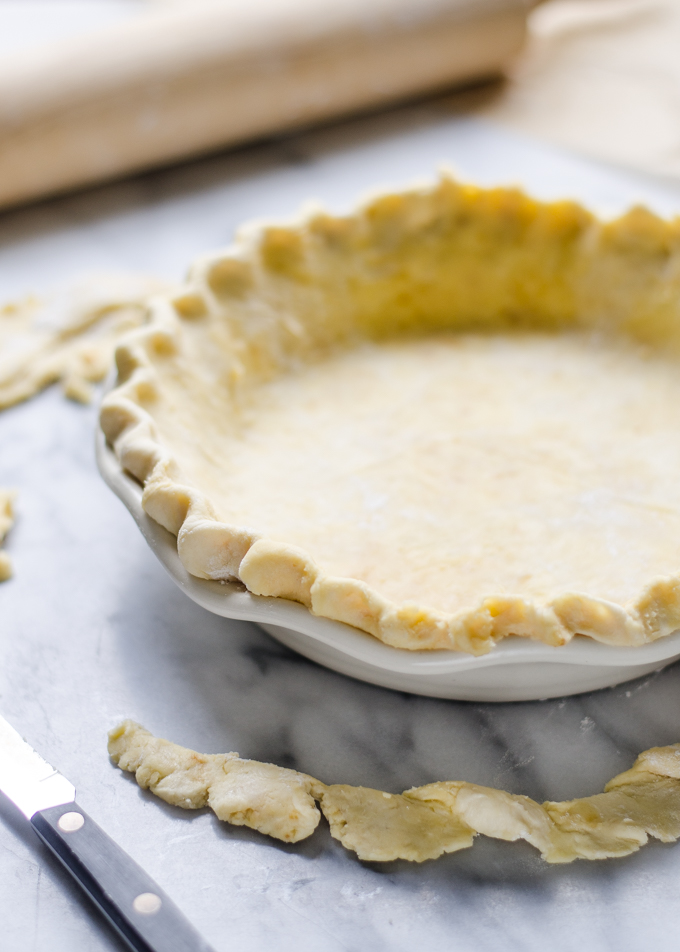
I am continually amazed by the vast array of things you can make with sourdough. And it’s not just a healthy substitute for your go-to recipes. Oh no.
Every sourdough recipe I’ve tried is BETTER than any version of that dish I’ve made before.
Take this sourdough pie crust recipe for instance. I went into making it fully expecting it be an okay, acceptable pie crust. But it’s actually the flakiest, most tender pie crust I’ve ever made.
I’m no wizard when it comes to pie crusts, and this one was outstanding.
This is an all butter crust, and it’s oh so flaky and delicious with a hint of that sourdough flavor.
It’s perfect for either sweet pie or savory pies!
Let me show you how to make it for yourself!
Ingredients:
Here’s everything you’ll need:
- 2 cups organic all-purpose flour: I always recommend to use organic all purpose flour when working with sourdough because it’s easier on your starter.
- 1 tsp unrefined sea salt: I prefer to use unrefined sea salt. Keep in mind that unrefined sea salt tastes slightly less salty than table salt. So if you substitute table salt, you may want to decrease the amount slightly.
- 1 tbsp sucanat or sugar: Adding a little sweetener helps to balance out the tanginess of the sourdough. You could use any type of sugar you have on hand.
- 1 1/2 cup cold butter: Yes, this is a LOT of butter. Quite a bit more than what’s in a regular pie dough recipe. This helps to make this an ultra flaky crust. You’ll want to cut the butter into smaller pieces to make it easier to cut into the flour.
- 1 cup sourdough starter: Since this recipe doesn’t require you to raise bread, it’s LESS crucial that your sourdough starter is at peak fermentation. But an active and bubbly starter is always great! I haven’t experimented with sourdough discard in this recipe, but I’m guessing it would work pretty well. Just keep in mind that discard tends to be wetter than an active starter, and it will also be more sour.
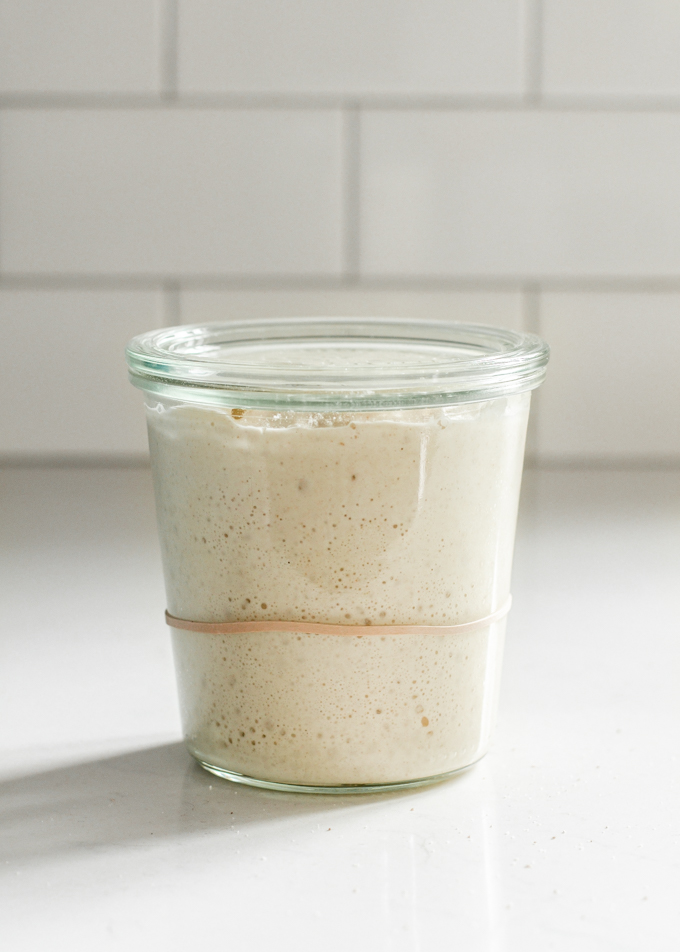
IMPORTANT: I keep my sourdough starter at 100% hydration, which means that I feed it equal parts flour and water. This is measured in weights, NOT volumes. In other words, I feed my starter 100 grams each of flour and water, NOT 1 cup each of flour and water.
If you want to make your own sourdough starter from scratch, make sure to check out my blog post all about making a starter! And if you’re having trouble with your starter, make sure to check out my Sourdough Starter Troubleshooting post.
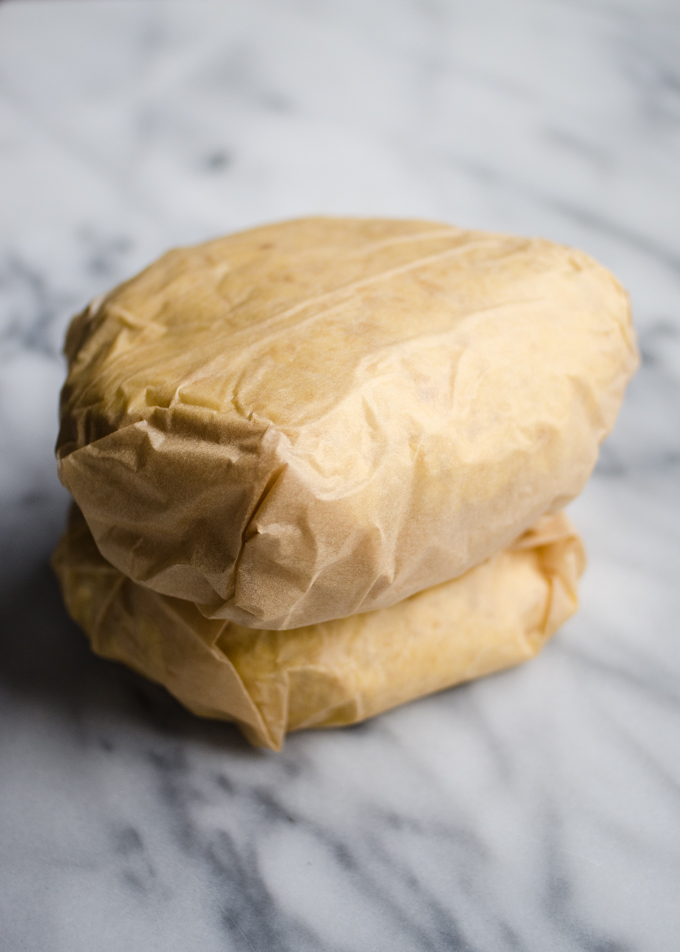
Mixing the Dough
Feeding the starter:
In the morning of the first day, feed your sourdough starter.
Mixing the Dry Ingredients:
That evening, when the sourdough starter is ready to go, mix together your dough.
Place the flour, salt, and sucanat in the bowl of food processor. Pulse to combine.
Cutting in the Butter:
Add the cold butter pieces to the flour mixture and pulse until the butter pieces are no larger than pea-size.
Alternatively, you could use a large mixing bowl and a pastry cutter (AKA pastry blender) instead of a food processor. But I personally think the food processor is the best way to cut in the butter.
Adding the Sourdough Starter:
Dump the mixture into a large bowl. Add 3/4 cup of the sourdough starter and use your hands to mix it into the dough. You could use a spatula or wooden spoon instead, but your hands are a great way to mix this!
Mix/knead just until the dough comes together in a cohesive ball.
Add more starter as needed to achieve the right consistency.
Fermenting the dough:
Cover the bowl with a plate and let it sit at room temperature for 7-12 hours.
Chilling the dough:
After the fermentation, divide the dough in half. Shape each half into a flattened disc and wrap with parchment paper.
You could also use a piece of plastic wrap (AKA cling wrap), but I prefer parchment paper.
Place in the refrigerator until completely chilled, about 1-2 hours.
After the dough is chilled, you can use it in your recipe!
This makes enough dough for 2 single pie crusts, or 1 double pie crust.
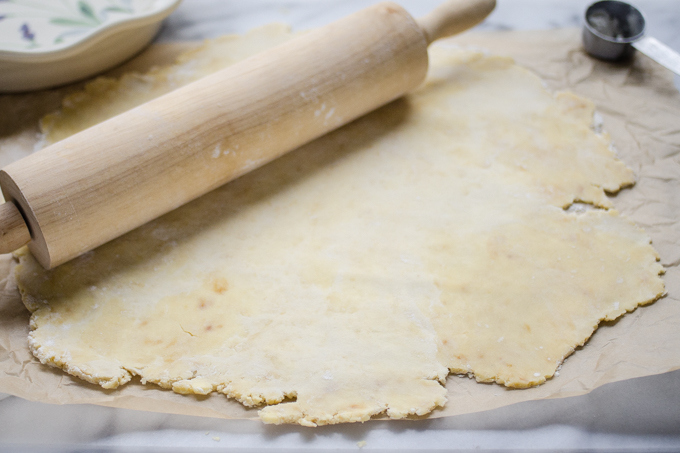
Rolling the Dough
Now it’s time to roll out the dough for your sourdough pie crust!
Unwrap your pie dough on your work surface.
Sprinkle the parchment paper and the top of the dough with flour. Next, flip the dough and flour the underside (which is now the top) with flour as well.
Then, using a floured rolling pin, roll the dough out to a few inches bigger than your pie plate.
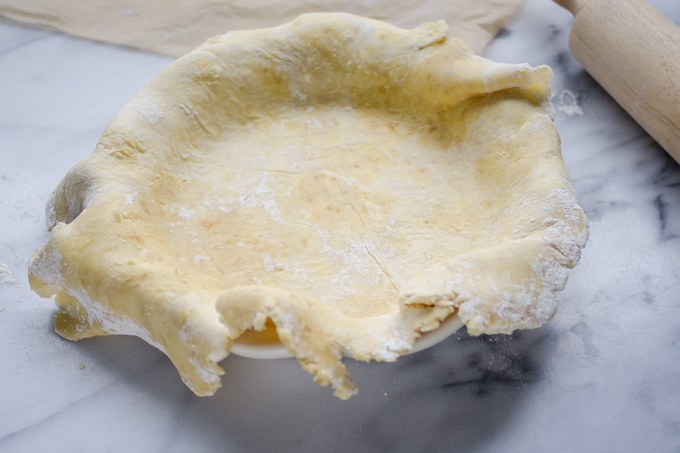
Shaping the Crust
Transfer the dough to the pie plate. I find it’s easiest to pick up the piece of parchment paper, invert the dough into the pie dish, and peel the parchment paper off the top.
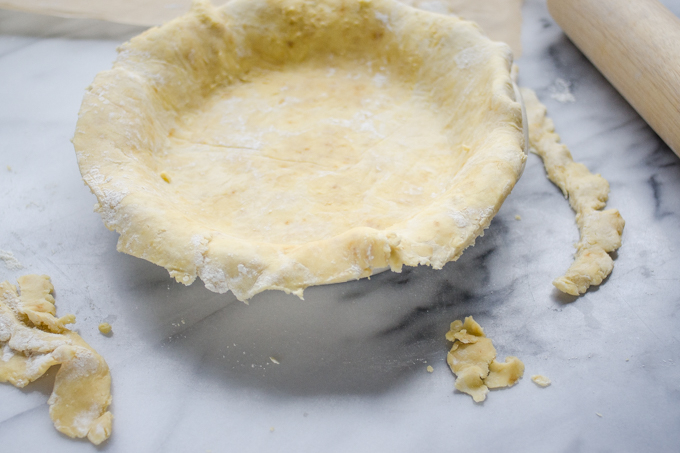
Trim the excess dough off of the edges of the crust. Make sure to save the scraps for later!
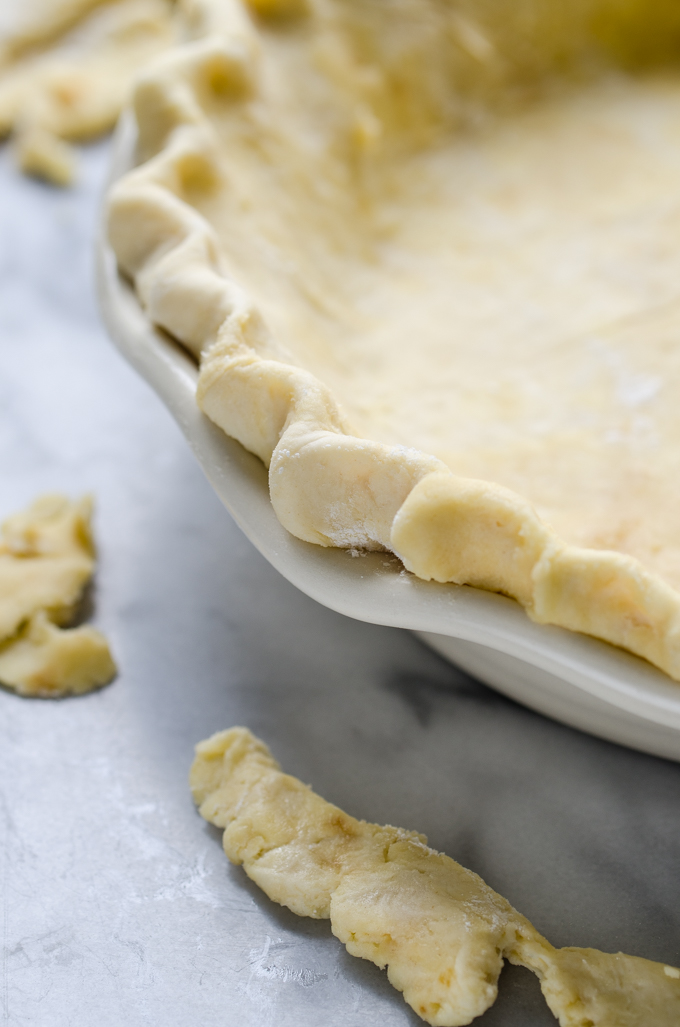
At this point you can seal/decorate the edges as you like. If this is a single crust pie, like pumpkin pie, you can go ahead and crimp the edges.
But if you’re going to put another crust on top, wait until put in the pie filling and top the crust to seal the edges.
If you you’re going to blind bake your sourdough crust, pie weights are an absolute must. I’ve tried blind baking without them, and it’s a disaster, trust me.
Quick Tip: Place your pie pan on a baking sheet to catch any potential butter drips and save your oven from getting dirty!
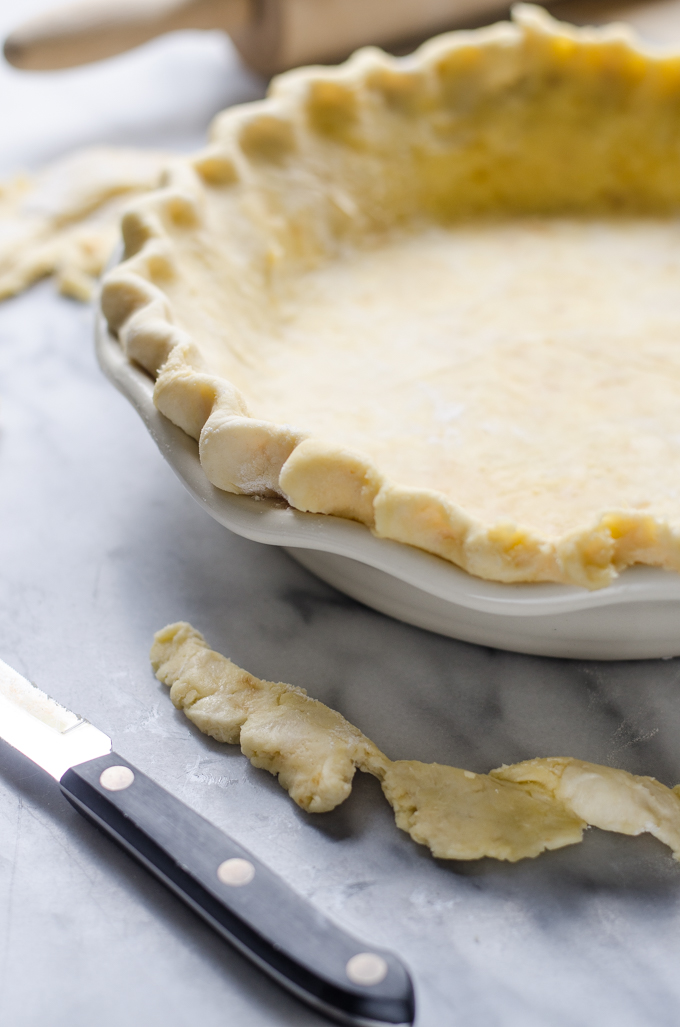
How Does Sourdough Pie Crust Taste?
This crust has a slight tang from the sourdough. But if you didn’t know it was sourdough, you wouldn’t be able to detect it. Basically, it adds a lovely flavor that isn’t overpowering.
If you have a sourdough starter, I highly recommend giving this pie crust a try. Use it for all your fall/Thanksgiving pie needs, or whenever you get a pie craving!
Can You Freeze Sourdough Pie Dough?
Yes, definitely! Wrap your sourdough pie dough really well in parchment paper and place in a freezer bag.
Make sure to remove as much air as possible from the bag.
Store in the freezer for up to a month.
How to Use Sourdough Pie Crust:
You can use this sourdough pie crust for just about any of your pie recipes, but here are a few ideas:
- This is so good for savory pies. I have used this to make the most bomb chicken pot pie ever.
- You could also make hand pies, which would be so fun!
- Apple pie would pair really well with the tanginess of the sourdough.
More Sourdough Recipes:
- The Best Sourdough Pancakes
- Sourdough Cranberry Orange Rolls
- How to Make Artisan Sourdough Bread
- Sourdough Pull Apart Rolls
- Sourdough Sandwich Bread
- Overnight Sourdough Waffles
- Sourdough Dutch Baby/German Pancake
Pie Recipes:
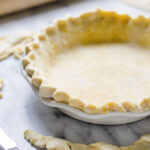
Sourdough Pie Crust
This sourdough pie crust is long fermented and super flaky and a tiny bit tangy.
Ingredients
- 2 cups organic all-purpose flour
- 1 tsp unrefined sea salt
- 1 tbsp sucanat or sugar
- 1 1/2 cup cold butter, cut into 1/2-inch pieces
- 1 cup sourdough starter, unfed (see note)
Instructions
-
Place the flour, salt, and sucanat in the bowl of food processor. Pulse to combine.
-
Add the butter pieces and pulse until the butter pieces are no larger than pea-size.
-
Dump the mixture into a large bowl. Add 3/4 cup of the sourdough starter and use your hands to mix it into the dough. Mix/knead just until the dough comes together in a cohesive ball. Add more starter as needed to achieve the right consistency.
-
Cover the bowl with a plate and let it sit at room temperature for 7-12 hours.
-
After the fermentation, divide the dough in half. Shape each half into a flattened disc and wrap with parchment paper. Place in the refrigerator until completely chilled, about 1-2 hours.
-
After the dough is chilled, you can use it in your recipe!
Recipe Notes
An "unfed" sourdough starter is one that has been fed 8-12 hours previously and can pass the float test. I suggest feeding your sourdough starter around noon, making your dough at night, and letting it ferment overnight.
This recipe was tested with a 100% hydration starter: basically, feed your starter with equal weights of flour and water.
Recipe adapted from Cultures For Health
Originally published on September 26, 2018

Morgan
Wednesday 4th of January 2023
So yummy and easy! I made this crust to use with a French silk pie for Christmas. Everyone loved it! It was delicious and the recipe was easy to follow. I've made it twice now it was so good. Thank you for creating and sharing this recipe!
Priscilla
Sunday 13th of November 2022
Erica, if I am making a pumpkin pie do I cut all the crust ingredients in half for just one pie? Can't wait to make this recipe! Thanks!💜
Erica Kastner
Monday 14th of November 2022
Yes, you can cut the recipe in half to make a single pie crust (just the bottom, not the top crust as well)! Hope you enjoy!
Julia
Tuesday 20th of September 2022
This is exactly the recipe that I’ve been using for a while because it tastes great; however I often have an issue with butter dripping out and burning all over the oven.. I always put a pan under, but I made several pies last time and couldn’t contain it! My pies were smoky tasting.. I thought I’d look for a change, but am finding pretty much the same recipes. Any tips for avoiding that problem? Thank you.
Erica Kastner
Tuesday 20th of September 2022
This recipe is quite butter heavy. You could try making sure that your crust is chilled before putting it in the oven. Or you could reduce the amount of butter. You may find that it's less flaky, but you may also prefer the taste and texture that way!
Kate
Monday 23rd of November 2020
I'm making a pecan pie. Do I bake the crust first? What Temp? Do I put beans or weights or something in the dish.
Erica Kastner
Monday 23rd of November 2020
I would just follow the directions for your pecan pie. Does the recipe say to blind bake the crust first?
Emily
Sunday 15th of November 2020
Two years later, do you still like this pie crust? Do you have trouble with the butter shrinking the crust as it bakes?
Erica Kastner
Monday 16th of November 2020
I haven't made this crust this year, but I don't recall it shrinking as it baked. I love that it's long fermented and it turns out so flaky for me!